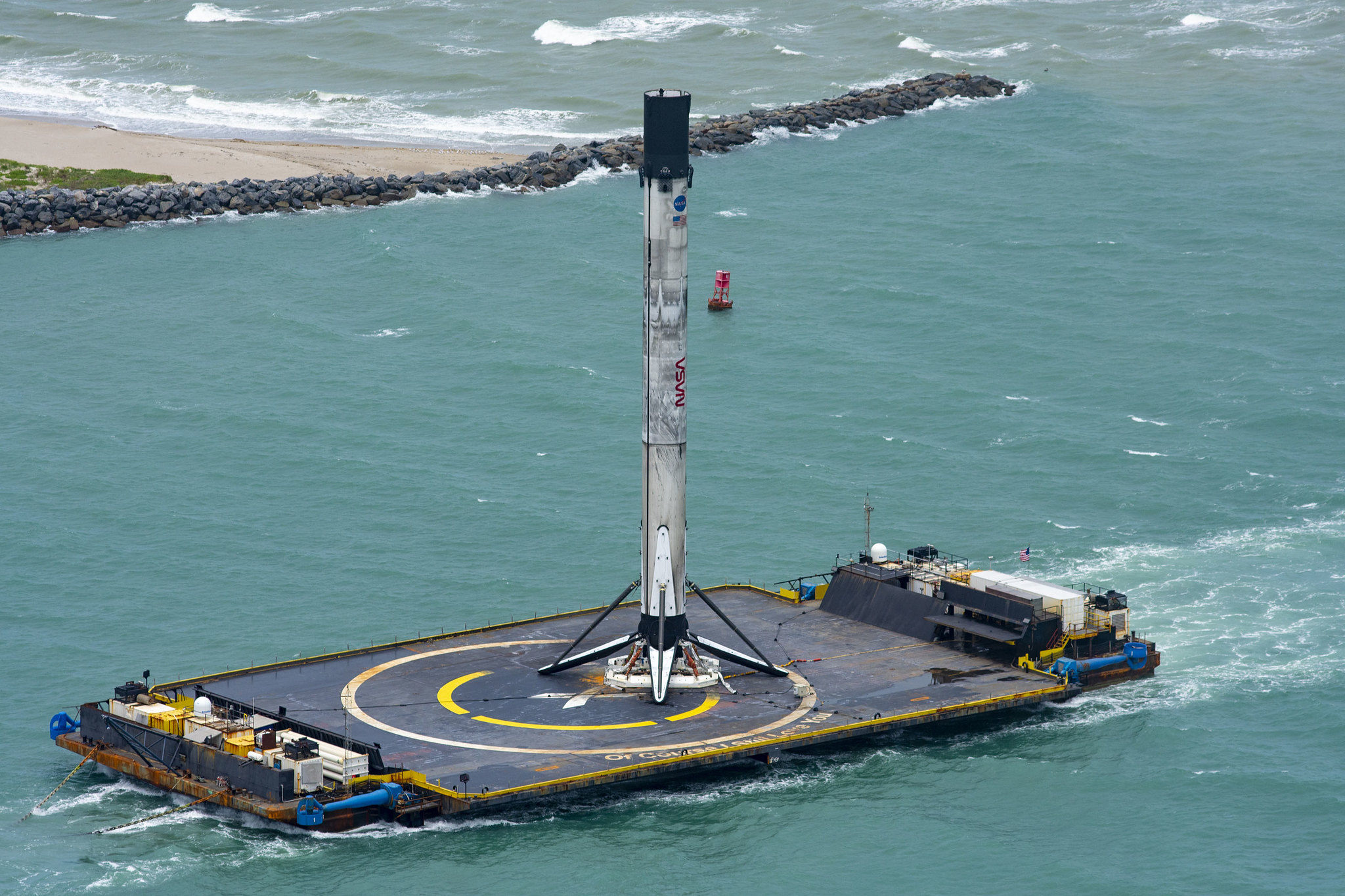SpaceX has continued working towards a faster and faster booster turnaround time. One of the main challenges in the way of instant launches is the process of refurbishing a used Falcon 9 booster. Once the booster has successfully landed there are a lot of steps prior to it launching again.
To refurbish a booster SpaceX starts by transporting the booster to a SpaceX facility from either the landing pad or mobile drone ship. SpaceX then goes through a thorough series of tests on critical parts, including the engines, landing legs, hydraulics/grid fins, fuel tank, and more. Once everything has been checked and fixed where necessary, the booster is cleaned and readied for the next launch.
Refurbishing a used booster is no easy task. Not only are there a lot of different parts but any mistake could end up costing SpaceX the next mission. SpaceX has continued to speed up this process and is working towards an even faster refurbishment time. As SpaceX gets more confident and better at the process, they will be capable of extremely fast turnaround times.
Why Does The Booster Need To Be Refurbished?

SpaceX’s most-used rocket, the Falcon 9, is partially reusable. This means that after launch the Falcon 9 booster falls back towards Earth and manages to land by itself on either a drone ship or a landing pad. After landing, the booster has been put through a lot of different stresses and needs to be checked prior to the next launch. These stresses include the force of landing, engine thrust, falling back to Earth, and more. While SpaceX is working towards instant reusability like an airplane, they are not there just yet. Instead of launching the rocket soon after landing, the booster has to go through a thorough inspection process of each critical part. The reason for this is certain parts are prone to damage and if left unfixed could end up costing SpaceX the next mission. The refurbishment process ensures that the booster will be able to successfully complete its next mission.
What Does The Refurbishment Process Look Like?
There are a lot of different parts of the refurbishment process. It all starts at either the landing pad or drone ship. If the booster landed on a drone ship, the drone ship moves to its local port where SpaceX first works to lift the rocket and retract the landing legs. The landing legs were deployed for landing but need to be retracted prior to transporting the booster any further. Once folded, the booster is carefully placed on a massive trailer.
This trailer then transports the used booster to a large SpaceX facility. Here in the large facility, SpaceX begins working on all the different aspects of the booster. Some of the main components they focus on are the engines, landing legs, hydraulics/grid fins, fuel tank, heat shield, and more. Starting with the 9 Merlin engines, SpaceX checks to make sure nothing is wrong with them. Since the engines are subjected to so much force, SpaceX usually is looking for any obvious damage including possible burn-through points. Additionally, they make sure every detailed aspect of the engine is correct and ready for the next launch.
SpaceX then checks parts like the landing legs. The landing legs are one of the slowest parts of reusing the Falcon 9 booster. The reason is they are very complex and end up taking a lot of force on impact. This requires a decent amount of work once transported to ensure they are ready for the next launch. The Falcon 9 uses very large grid fins powered by hydraulics to help orient itself on its path to a landing pad. The grid fins fold in and out and are crucial to a successful booster landing. SpaceX always works on the grid fins and ensures they are intact and the hydraulics that controls them are working properly.
One of the final big inspections that SpaceX does is on the fuel tank itself. SpaceX ensures there are no leaks or any damage to the main fuel storage. SpaceX goes on to check every aspect of the booster but these are some of the most important aspects. Finally, the booster often gets cleaned to look brand new and is ready for its next launch.
How Long Does It Take SpaceX To Launch A Used Booster?

SpaceX has continued to improve Falcon 9 booster turnaround time significantly since its first launch. While at first, it took over 100 days, recently SpaceX reused a booster that landed only 9 days prior. In comparison to the Space Shuttle, which was meant to be rapidly reusable, the quickest turnaround time for the Shuttle was around 50 days. SpaceX since the start has been slowly but surely lowering the booster turnaround time and speeding up with the refurbishment process.
At first, it took around 100 days, then they managed to get around 50, now it’s going under 10. Taking a closer look at the refurbishment process, a lot of the Falcon 9 booster parts are meant for many launches. So many that ideally, nothing is wrong with the booster at all after landing. As SpaceX has gotten even better in their refurbishment process they have also gotten more confident. These factors have combined to lower the turnaround time to under a month. While the time it takes is still not at SpaceX’s goal, they are consistently speeding up the process and are making good progress.
SpaceX’s Future Refurbishment Speed Goal
SpaceX is never lacking ambitious goals that many would consider impossible. With regards to refurbishment, SpaceX wants a Falcon 9 booster to land and within 24 hours be ready for its next launch. This has been the goal for Falcon 9 since the start and is what SpaceX has continued to work on. This fast turnaround time would allow Falcon 9s to launch extremely frequently. While SpaceX has made great progress, a 24 hour turnaround time is still far away. There are many reasons for this including the refurbishment process. It’s fast but not quick enough at the time being.
As SpaceX develops better hardware and becomes more confident with their rockets, the time will continue to speed up. One unique aspect of refurbishing a booster is all the things you learn after launch. This opportunity allows engineers and other SpaceX workers to see exactly what happened to every part of the hardware on each booster. This helps them build confidence and continue improving the Falcon 9 booster turnaround time.
How This Impacts The Overall Launch Speed
While a major reason why companies like SpaceX are making rockets partially and fully reusable is to save money, an equally important goal is speeding up launches. Reusability speeds up launches significantly as you don’t have to build an entirely new rocket or booster. This is why speeding up the refurbishment process is so important to SpaceX. They are not reusing the rocket just to save money but also to speed up and launch as frequently as possible.
Conclusion
There are a lot of different steps that go into refurbishing a Falcon 9 booster. SpaceX needs to check important parts including the engines, landing legs, hydraulics/grid fins, fuel tank, and more. Missing a single error could end up jeopardizing the next mission. SpaceX has continued to get better and more confident in this process. They have lowered the turnaround time significantly throughout the life of the Falcon 9. We will have to wait and see if they are able to continue their fast progress towards 24-hour reusability.
